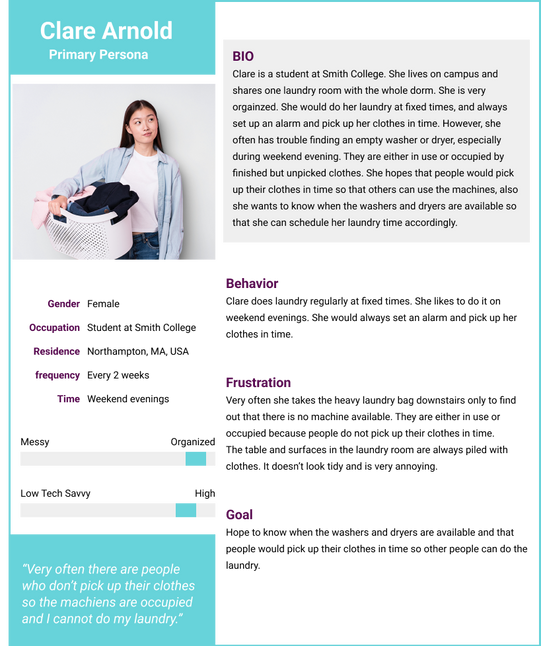EasyLaund
EasyLaund is a mobile app & basket product combo that aims to enhance the communal laundry room experience.
Independent Project Summer 2022
Overview
The Challenge
There are incidences of unreasonable utilization of resources in communal laundry rooms in colleges, universities and apartments, leading to the following problems:
-
difficulty of finding an available machine,
-
difficulty of temporarily storing the clothes in a clean and tidy way.
The Outcome
EasyLaund is my solution to the problem, which includes the following features:
mobile app
-
the services of room status checking,
-
notification system,
-
reservation,
-
credit and rewarding system.
basket product
-
providing a reasonable way for temporarily storing and managing the untaken clothes.
Highlight Feature Display
EasyLaund allows users to make reservations easily -- with in a few choices -- to secure a slot.
Background
The utilization rate of public resources -- how much the resources are being used comparing to its potential capacity -- has always been a concern of societies and institutions, for a reasonably high rate leads to a more efficiently run society or institution. This study started with in an interest in improving the utilization of public facilities and spaces in one specific common residential scenario — the communal laundry rooms in colleges, universities and apartments, where lots of improvements are needed.
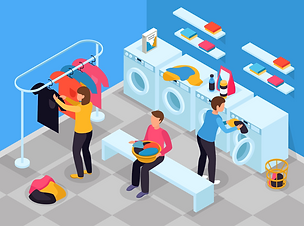
Research
In the research phase, I employed both primary and secondary study, used literature review, user interview and site study.

Literature review

Interview

Site Study
Literature Review
By reading dozens of related articles, I came to the following main findings:
1
Overall, the resources utilization rates in schools are not ideal.
A study of Washington DC public schools shows that the average facilities utilization rate of those schools in 2021 is merely 73%, where the optimal utilization rate should lie between 80% to 95%.
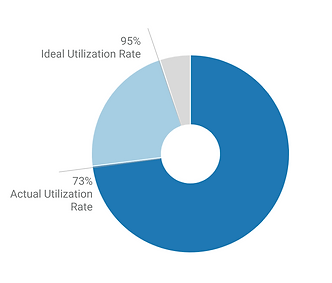
2
Other than sufficiency of facilities, the utilization rate in communal laundry rooms depends heavily on individual behaviors.
There are three major different types of laundry rooms. The first is private owned ones at home; those involve few people and conflicts are limited. The second is laundromat or laundry businesses; those are highly organized. The last type is community shared ones, which is of our interest. Comparing to the other types, the utilization performances in communal laundry rooms depend greatly on the behaviors of each resident other than the facilities themselves. Thus it is a more complicated situation with more potential problems.
3
There are in fact sufficient machines in most schools and apartments.
This can be seen by the study of suggested and actual Human - Machine ratio.
-
Suggested Human - Machine ratio:
Multi-housing Laundry Association has suggested the following human-machine ratio: 1 set of Washer and Dryer to 8-12 families in apartments or to 25-40 students in schools.
-
Actual Human -Machine ratio:
With the suggested ratio in mind, I investigated the actual human-machine ratio in seven locations through filed study and literature review. In seven scenarios, six are universities or colleges and one is apartment. Among them, only one shows insufficiency of facilities.


In sum, it is suggested that the facility utilization rate in communal laundry rooms are not ideal and many problems rise. But the problems are not usually caused by insufficiency of machines, but by conflicting individual behaviors.
Interview
To gain a whole picture of the impact on all related stakeholders, I interviewed 4 communal laundry room users and 2 related managers.
Users I interviewed three college or university students from different institutions and one adult living in an apartment, with 12 questions focusing on the set up of their communal laundry rooms, their habit of using laundry rooms, the process of using the laundry room, and the problems they encounter in the process. I gained following insights.
1
The biggest difficulty is to find an available machine. And unavailabilities are often caused by people not picking up their clothes in time.
“Somebody left the clothes in the washing mashing over night and it smells.”
“It takes 26 minutes to wash, but I would set an 30 minutes alarm. It’s a personal preference. You know, when you are doing homework or working on something, you don’t want to be disturbed.”
2
The current communication and notification methods do not work.
“No one uses the white board.”
“White board is dirty and messy.”
“Some people have a sticky note with their names and numbers. But who would call them and wait for them to come? That’s useless. I would just take their clothes out. ”
3
When machines are in short and occupied by untaken clothes, people would usually take other people's clothes out, but they lack a clean place to temporarily store the clothes and have many concerns about it.
“I don’t feel good taking other people’s clothes. It would be awkward if they see.”
“Many people’s stuff are piled there and they could easily get lost.”
“People after me is annoying. They would touch my clothes, take then out and leave on the table. They all get dirty again.”
“Top of the machine is cleaner than the table. We should have a place to keep the clothes temporarily.”
Managers I interviewed 2 related managers. I asked a staff in the facilities department of a college about the principles behind the planning, design, and the set up of college laundry rooms, and the process of reporting and resolving problems. And i asked a house keeper about her job and responsibilities in the laundry room and the problems she encounters or identifies there.
1
They confirmed with the severeness of the problem of untaken clothes.
“People don’t pick up their clothes. Every day I see this situation. Clothes can stay there for days even weeks.”
2
The house keepers wish to know the belongingness of the clothes so that they can properly deal with them.
“When students’ stuffs are missing, the first thing they’ll do is to ask housekeepers, did you see? But it’s not housekeepers responsibility.”
“The biggest problem is that I don’t know whose stuff is whose. Students leaving things behind when leave for summer. I don’t know if those belong to people who has left or people still here during summer; whether they forgot it or do not want it any more. “
High Level Insights:
-
The biggest problem the users have is not able to find an avaliable machine, which is often caused by the clothes that are not picked up in time.
-
There is not a good place for temporarily clothes keeping, which affect both the user and the manager.
-
From the house keeper’s point of view, the hardest question is the tracking of the clothes and how to deal with them properly.
Site Study
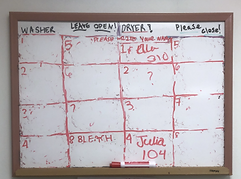
1

2
1
White board that is being used to track who is using which machine. But people need to use their fingers to erase the previous person’s record so it is very messy and uncomforting.
2
White board that meant to be a tracker as the previous one but gradually evolved into a note/drawing board because no one is using them in the intended way.


4
3
Untaken clothes: those clothes have been sitting in this washer for hours without being picked up.
4
Untaken clothes in the dryers for hours.
3

5

6
5
Piles of untaken clothes on public surfaces that never disappear.
6
Clothes can easily get lost when piled together, like this untaken sock.
Research Summary
-
A perfect human-machine ratio alone does not ensure easiness in finding availabe machines; a more reasonable and efficient utilization of the resource is very important too.
-
The primary need of the users is to find an avaliable machine, where whose unavailability is often caused by the clothes that are not picked up on time.
-
There is not a good place for short and long term clothes keeping, which affects both the user and the manager.
-
The biggest problem that the house keepers face is the tracking of the clothes and how to deal with the untaken clothes properly.
-
There is no working method to remind the students to take out their clothes on time.
Analysis
Persona
User Journey Map

Competitive Analysis
I chose four competitors that are most suitable for a multi-housing communal laundry setting and evaluated those products in four aspects that are most relevant to my project: the machine status displaying, the notification function, the scheduling function and the payment function.
Automatic Laundry has a very clear way of showing the machine status, which shows not only whether a cycle is done but also whether the clothes have been taken out. This is definitely a helpful feature in the situations that I am interested in.
Inspiration
None of the existing app has a schedule function that I assume would be helpful. Thus this is an opportunity for me to add in this feature myself and make an improvement.
Opportunity

Problem Statement
There are incidences of unreasonable utilization of resources in communal laundry rooms in colleges, universities and apartments, including the difficulty of finding an available machine and of temporarily storing the clothes in a clean and tidy way. We might solve the problem by providing the service of status checking and notification and a reasonable way of temporarily storing and managing of the untaken clothes.
Ideation & Design
Brainstorm
After defining the problem statement through analyzing the research results, I came to the ideation process. I generated ideas of possible solutions through brainstorming and grouping the ideas into affinity diagrams. At the end of the process, I identified the main features that I came up for my product to be:
-
detailed status displaying of machines in the laundry rooms;
-
a repeatable and reliable notification system;
-
scheduling and reserving functions;
-
an encouraging credit system;
-
storage baskets;
-
preference setting on privacy; and
-
a comunity communication system.

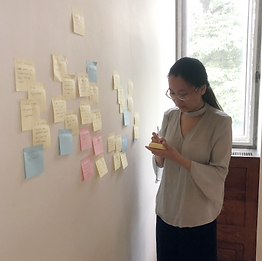
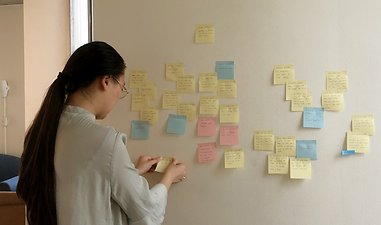

Story Board
1. How the app makes it easier to start a laundry by allowing people to know the status of the laundry room and to move untaken clothes to a basket. Meanwhile, it keeps reminding the users of untaken clothes and help them track where the clothes are.
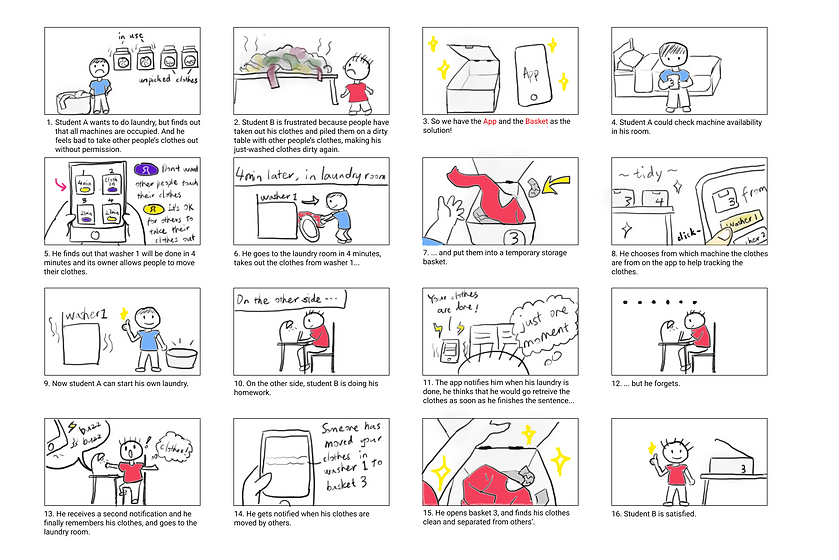
2. The product solves the problem of piling clothes on public surfaces by setting up a recycling and notification system.
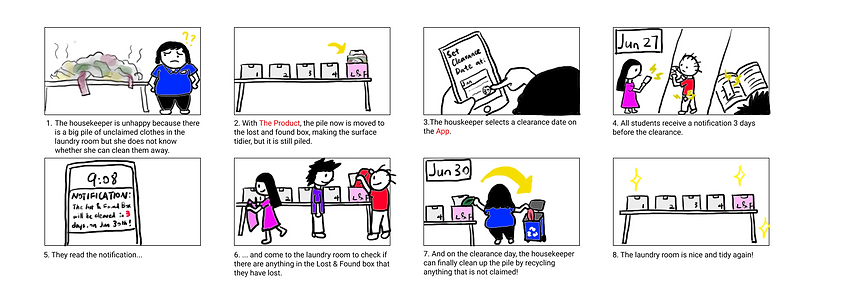
Wireframing
Click on the picture to enlarge.

Basket Design

Final Basket Design



Describe your image





Final Outcome & Usage Scenario
Initial Designs


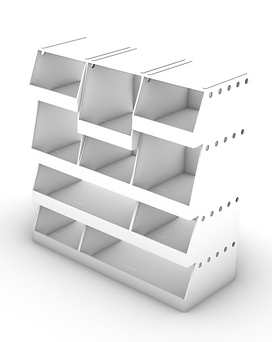
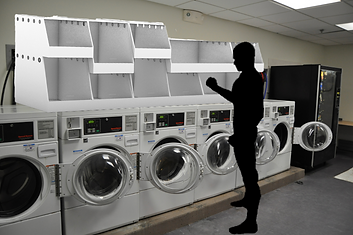
Usability Test
After creating the prototype of the app, I designed a usability test with scenarios that users would normally encounter, including
-
Checking the laundry room status.
-
Moving clothes to baskets when there is no other availble machine.
-
Using the machines
-
When there are unclaimed clothes in the machine/ when your own clothes are missing
-
When you cannot pick up your clothes in time.
I conducted the usability test with 4 people, and received the following insights:
-
Visibility of system status & Recognition rather than recall
-
Need not just icons but also titles in the tab bar.
-
Need a title for all pages.
-
-
Aesthetic and minimalist design (emphasis on important things)
-
The button for Laundry Room is too mall and hard to notice (2 people), while “laundry in process” is too large. This is the wrong emphasis.
-
Too many steps required to get to Laundry Room A to see the status.
-
-
Flexibility and efficiency of use
-
For the scenario “when your clothes are missing,” one user went to “my record,” wishing to see who is the person after her and to contact that user; one user went to “community - notification,” since she thought this is the place for group chat.
-
For the scenario “when you see some unclaimed clothes in the machine,” two people went to the “community-chat” to send group messages.
-
-
Consistency and standards (external)
-
It is confusing when there is a start button on both the app and the machine.
-
The notification when the laundry is done shouldn’t look like an alert, the user thought something was wrong. And press the done button twice is confusing, should make it more obvious that the second time is on the machine.
-
-
Error prevention & Help users recognize, diagnose, and recover from errors
-
The punishment should not be too harsh. For example, someone suddenly has a meeting so she cannot pick up the clothes in time, but if that should harm the credit it would be very frustrating.
-
The “Upload Image” function in “Unclaimed Clothes Report” could harm privacy.
-
-
Help and documentation
-
It is hard to imagine that you can report unclaimed clothes when you don’t know this function, since “report” is usually associated with bugs.
-
-
Match between system and the real world (Use the words that users can understand)
-
One user does not know what “other time” refers to.
-
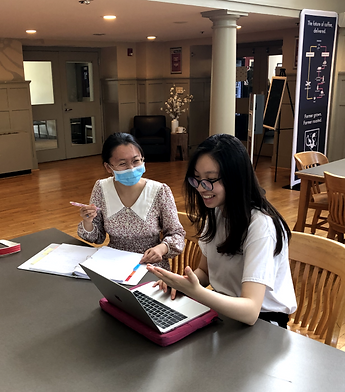

High Fidelity Prototype
I made changes according to the insights from usability test, and came up with this final product.
Laundry -- No laundry in Process/ Upcoming Reservations

Laundry -- No laundry in Process/ Upcoming Reservations
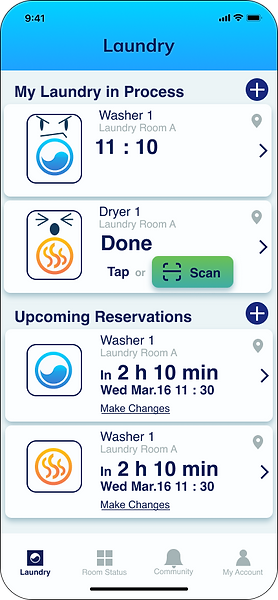
Personification making the laundry status more visible.
More emphasis is only placed on the most likely needed button. When there is no laundry, users might want to start one; but when there is laundry in process, users often care more about what to do when it is done.
Reservation -- shows all reservations in a clear list.

Quick Match -- with 2. “Time Duration” in detail
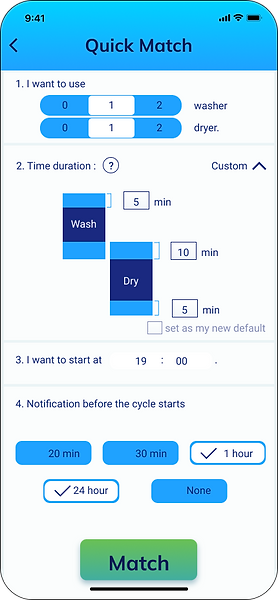
Quick Match -- with 3. start time in detail

Room Status -- summary
Applying easy-to-pick choices instead of a fill-in field.
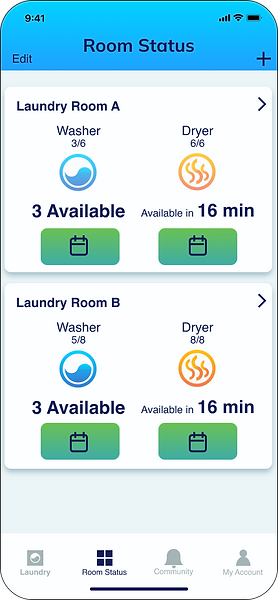
Shows availability of all rooms at a glance without unnecessary details.
Laundry Room A -- card view
Laundry Room A -- 3D view

A Display filter that allows users to choose to display “all,” “available only,” “washer only” and “dryer only,” and show in order of “number” or “availability,” making it easier to identify the targeted machines.
A 3D map view allows the users to see the overall availability at a glance and to help find a specific machine in a room.

Community
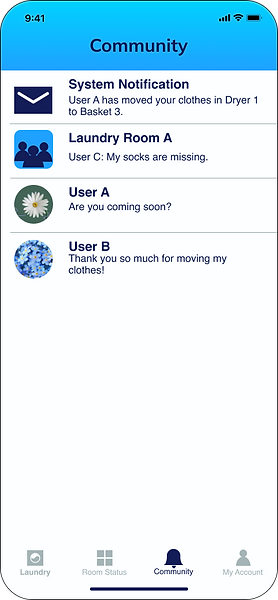
A place where users can receive system notifications, chat 1 on1 or in group.
My Account

Reflection
Take Aways
This is my first UX project. I have learnt a lot from it. The most important take away is a systematic study of the double diamond model of design process, in which I started with an insight of potential problem, did research to fully understand the problem space, analyzed the research result using design tools like persona, user journey map and competitive analysis to narrow down and identify the problem space, then brainstormed and realized the solution design through story board, wireframing, prototyping, modeling, and user test and iterations.
Through this process, I have also developed more skills. I self-learnt many related design tools, including PS, Figma, Balsamiq and Rhino. And I have also gained experience on doing first hand research, especially on how to ask questions without leading to an anticipated answer in interviews and usability tests, which is very important to true discovery.
Next Steps
If I had more time in this project, I would practice more and improve my UI with a more refreshing and glass like design, as well as complete the design of credit and rewarding system.
